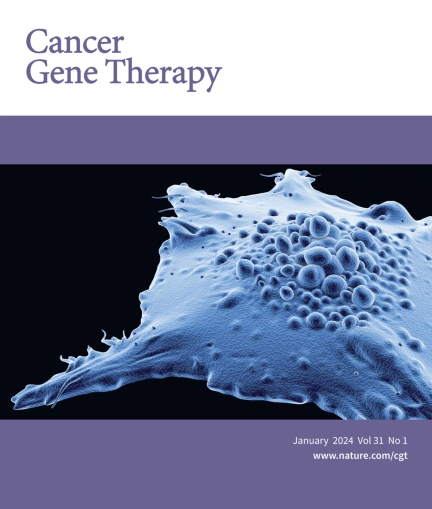Has_circ_ASH1L acts as a sponge for miR-1254 to promote the malignant progression of cervical cancer by targeting CD36
IF 5
3区 医学
Q1 BIOTECHNOLOGY & APPLIED MICROBIOLOGY
引用次数: 0
Abstract
Cervical cancer (CC) is a prevalent gynecological malignancy. Increasing evidence suggests that circular RNAs (circRNAs) play a pivotal role in the pathogenesis of CC. However, the regulatory function of circ_ASH1L in CC remains elusive. In this study, we aim to elucidate the precise role and underlying mechanism of circ_ASH1L in the malignant progression of CC. The human CC dataset GSE102686 was extracted from the Gene Expression Omnibus (GEO) database for the analysis of differentially expressed circRNAs. Target gene prediction softwares were utilized to predict the binding of miRNAs to circ_ASH1L sponge. The expression level of circ_ASH1L in CC tissues and cells was detected by quantitative real-time polymerase chain reaction (qRT-PCR). The characteristics of circ_ASH1L were determined by RNase R digestion, actinomycin D, and nucleo-plasmic separation assays. The effects of circ_ASH1L, miR-1254, and CD36 gain-and-loss on the malignant progression of CC were investigated using Cell Counting Kit-8 (CCK-8), colony formation, flow cytometry, wound scratch, transwell, and Western blot assay. The effect of circ_ASH1L on tumorigenicity of CC cells in vivo was evaluated in nude mice through tumor xenograft assay. The targeted regulatory relationship between circ_ASH1L/miR-1254 as well as miR-1254/CD36 was validated by dual-luciferase reporter assay. We screened the differentially expressed circ_ASH1L from the GEO dataset GSE102686 and confirmed its circular structure. Furthermore, we observed a significant upregulation of circ_ASH1L in both CC tissues and cells. Overexpression of circ_ASH1L promotes proliferation, invasion, and migration of CC cells while inhibiting cell apoptosis. However, silencing circ_ASH1L showed opposite results and inhibited tumorigenicity of CC cells in nude mice. Furthermore, we have identified circ_ASH1L as a miR-1254 sponge in CC cells. Notably, our in vitro experiments demonstrated that exogenously modulating the expression of miR-1254 effectively counteracted the impact of circ_ASH1L on the malignant phenotypic characteristics of CC cells. Similarly, modulation of CD36 expression efficiently counteracted the effect of miR-1254 on the malignant biological behavior of CC cells. In conclusion, circ_ASH1L promoted the malignant progression of CC via upregulating CD36 expression through sponging miR-1254.

Has_circ_ASH1L作为miR-1254的海绵,通过靶向CD36促进宫颈癌的恶性进展。
宫颈癌是一种常见的妇科恶性肿瘤。越来越多的证据表明,环状rna (circRNAs)在CC的发病机制中起着关键作用,然而circ_ASH1L在CC中的调节功能尚不清楚。在这项研究中,我们旨在阐明circ_ASH1L在CC恶性进展中的确切作用和潜在机制,从基因表达Omnibus (GEO)数据库中提取人类CC数据集GSE102686,用于分析差异表达的circRNAs。利用靶基因预测软件预测mirna与circ_ASH1L海绵的结合。采用实时荧光定量聚合酶链反应(qRT-PCR)检测circ_ASH1L在CC组织和细胞中的表达水平。circ_ASH1L的特性通过RNase R酶切、放线菌素D和核质分离测定来确定。使用细胞计数试剂盒-8 (CCK-8)、集落形成、流式细胞术、伤口划伤、transwell和Western blot检测circ_ASH1L、miR-1254和CD36的获得和丢失对CC恶性进展的影响。通过裸鼠肿瘤异种移植实验评价circ_ASH1L对CC细胞体内致瘤性的影响。circ_ASH1L/miR-1254和miR-1254/CD36之间的靶向调控关系通过双荧光素酶报告基因实验得到验证。我们从GEO数据集GSE102686中筛选了差异表达的circ_ASH1L,并确认了其圆形结构。此外,我们在CC组织和细胞中观察到circ_ASH1L的显著上调。过表达circ_ASH1L可促进CC细胞增殖、侵袭和迁移,同时抑制细胞凋亡。然而,沉默circ_ASH1L显示相反的结果,并抑制裸小鼠CC细胞的致瘤性。此外,我们已经确定circ_ASH1L是CC细胞中的miR-1254海绵。值得注意的是,我们的体外实验表明,外源性调节miR-1254的表达可以有效抵消circ_ASH1L对CC细胞恶性表型特征的影响。同样,CD36表达的调节有效地抵消了miR-1254对CC细胞恶性生物学行为的影响。综上所述,circ_ASH1L通过海绵化miR-1254上调CD36表达,促进CC的恶性进展。
本文章由计算机程序翻译,如有差异,请以英文原文为准。
求助全文
约1分钟内获得全文
求助全文
来源期刊

Cancer gene therapy
医学-生物工程与应用微生物
CiteScore
10.20
自引率
0.00%
发文量
150
审稿时长
4-8 weeks
期刊介绍:
Cancer Gene Therapy is the essential gene and cellular therapy resource for cancer researchers and clinicians, keeping readers up to date with the latest developments in gene and cellular therapies for cancer. The journal publishes original laboratory and clinical research papers, case reports and review articles. Publication topics include RNAi approaches, drug resistance, hematopoietic progenitor cell gene transfer, cancer stem cells, cellular therapies, homologous recombination, ribozyme technology, antisense technology, tumor immunotherapy and tumor suppressors, translational research, cancer therapy, gene delivery systems (viral and non-viral), anti-gene therapy (antisense, siRNA & ribozymes), apoptosis; mechanisms and therapies, vaccine development, immunology and immunotherapy, DNA synthesis and repair.
Cancer Gene Therapy publishes the results of laboratory investigations, preclinical studies, and clinical trials in the field of gene transfer/gene therapy and cellular therapies as applied to cancer research. Types of articles published include original research articles; case reports; brief communications; review articles in the main fields of drug resistance/sensitivity, gene therapy, cellular therapy, tumor suppressor and anti-oncogene therapy, cytokine/tumor immunotherapy, etc.; industry perspectives; and letters to the editor.
文献相关原料
公司名称
产品信息
索莱宝
crystal violet
 求助内容:
求助内容: 应助结果提醒方式:
应助结果提醒方式:


